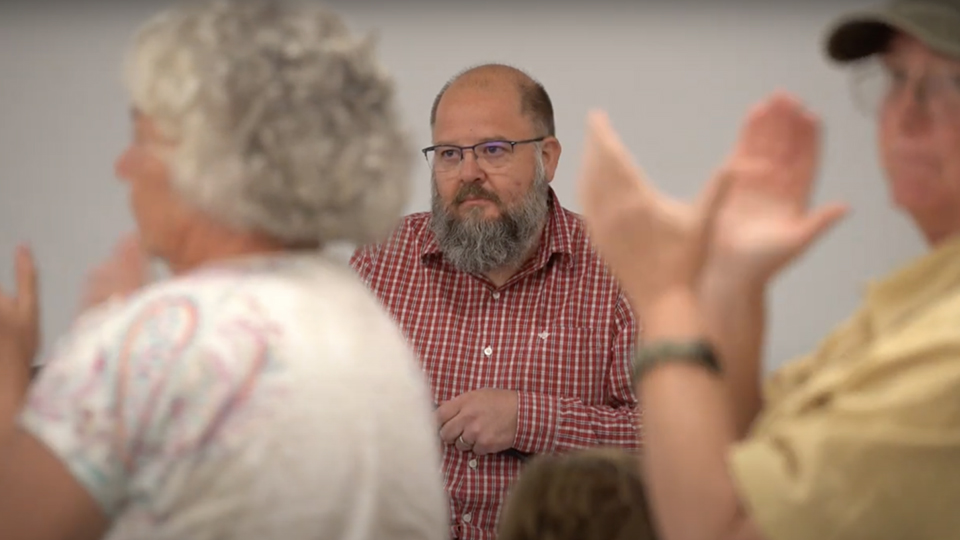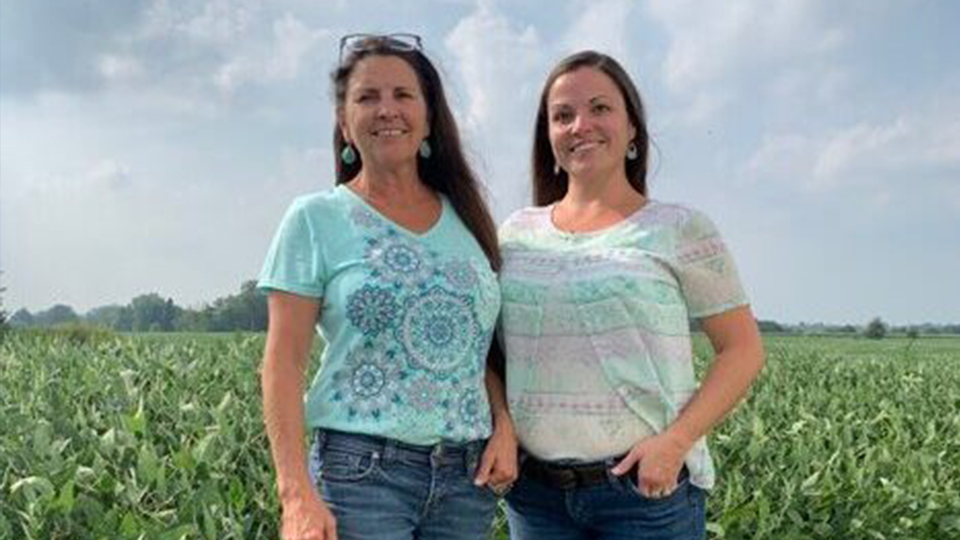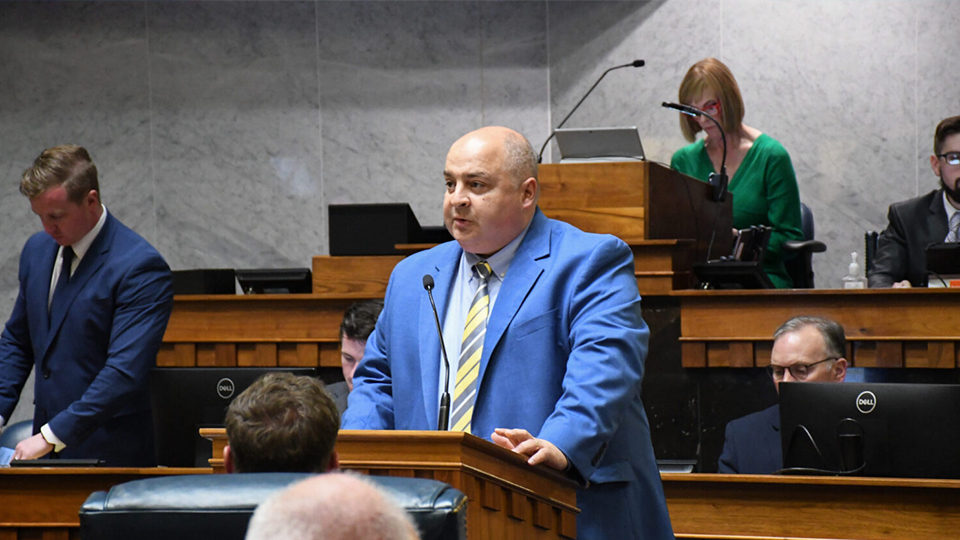As company forges on with carbon sequestration project, residents mobilize
Subscriber Benefit
As a subscriber you can listen to articles at work, in the car, or while you work out. Subscribe Now
Susan Strole-Kos grew up bottle-feeding calves, putting up hay and repairing tractors on her family’s 100-acre farm in Vigo County. The land, a dairy farm turned soybeans and corn operation, has been in the family for two centuries.
When her parents died — her father in 2013, her mother in 2021 — Strole-Kos was devastated. Their deaths, she said, were “like losing a part of my body.”
Her parents had wanted never to sell the land. So Strole-Kos took over the business, and brought a cousin in to continue farming.

She spends her days working outside, and so does her family: the grandchildren, five and eight, wake up every morning during the summer to pull weeds in the garden before playing in the afternoons. Strole-Kos’ daughter Whitney is teaching the children to can the produce they grow.
“We’re very happy,” Strole-Kos said. “… We don’t need anything big in our life. We just need our land, our home and our family. That’s it.”
But that land, including the 1865 farmhouse she spent two decades restoring, lies in between two planned carbon dioxide injection sites.
Wabash Valley Resources (WVR) intends to pipe and inject 1.67 million tons of carbon dioxide annually a mile below the area’s surface as part of its plan to produce “green” anhydrous ammonia fertilizer at a former coal gasification plant in Vigo County.
The company — based in West Terre Haute and formed in Delaware — envisions investment, jobs and plenty of reasonably priced, sustainably produced fertilizer.
But Vigo and Vermillion County residents near the injection sites fear potential consequences like pipe ruptures and water contamination. They’re skeptical of the company’s intentions — and its use of public incentives.
“We’re trying to build for our kids: my kids, grandkids, great-grandkids, eventually,” said Tammy Sanquenetti, whose family lives less than a mile from one of the proposed injection sites. “There are too many unknowns.”
Wabash Valley Resources Vice President of External Affairs Greg Zoeller said the company had attempted to address concerns in two ‘town hall’-style meetings, but said, “The fear of the unknown is strong.”
Project fertilizer
The United States in 2022 was the world’s second-largest importer of fertilizers, purchasing 10.7 million metric tons, according to the World Integrated Trade Solution.
WVR aims to disrupt those imports by producing 500,000 metric tons of anhydrous ammonia fertilizer annually — half of the amount it says the Eastern Corn Belt uses each year.
Alongside competitively priced, homegrown fertilizer for farmers, WVR expects the plant to produce 100 permanent jobs with salaries averaging $129,000 and up to 500 union construction jobs, according to a media kit.
Connecticut-based Philipp Brothers Fertilizer and investors snapped up the former SG Solutions gasification plant in West Terre Haute in 2016, according to parent company Phibro.
“There’s been work going on on this project since then,” WVR’s Zoeller said.

The company estimates that retrofitting the gasifier into an anhydrous ammonia-maker will allow it to bring the plant online in half the time of similar projects. It hopes to begin production in 2026.
WVR plans to liquify the carbon and pump it through 11 miles of pipeline to the injection sites for permanent storage 5,400 feet underground.
The pipeline will be eight inches in diameter and buried at least five feet deep, according to WVR spokesman Pete Rimsans. Its exact path is still in negotiations, he said.
To operate, the plant needs to clinch a final Class VI permit — regulating carbon dioxide sequestration — from the U.S. Environmental Protection Agency.
The EPA has granted just one thus far: to the Archer Daniels Midland Company operating in Macon County, Illinois, according to the agency. And it’s approved a single draft permit: to WVR.
The company is also working to secure air permit modifications from the Indiana Department of Environmental Management (IDEM).
Making plans reality
WVR has drawn on a variety of local and federal resources — and state legislation — prompting deep skepticism from residents.
To finance its efforts, WVR has landed two U.S. Department of Energy grants totaling $66 million.
It addition, it plans to take advantage of recently increased federal tax credits for such projects. The 2022 Inflation Reduction Act raised the credit for permanent carbon dioxide sequestration from $45 per metric ton to $85. They expire 12 years after a facility goes into operation; WVR says it plans to inject for 12 years.
The Vigo County Council also voted in July to offer the company a 10-year, 100% property tax abatement, WTWO/WAWV-TV reported.
“It’s all about money. It’s corporate socialism, is what it is,” said Doug Martin, president of the town of Universal’s board. The town is within Vermillion County.
“It’s the rich getting their hand-out. None of these people across the country … wanted to do any kind of carbon sequestration or anything. ‘Oh, it won’t work! It’s going to cost too much!’” said Martin, who lives about two miles from a proposed injection site. “Well, as soon as those tax credits went through, they’re all on board.”
The company says it’s not profiting off the help.
“If you look at the cost of the process of capturing the carbon, liquefying it, piping it to an injection site and storing it, the $85-a-ton should actually pay for the input costs,” Zoeller said. “So we have a loan that they believe will be paid off using the carbon credits.”
“It actually is meant to equal the upfront costs and the maintenance costs of this whole system,” he added. “I mean, we wouldn’t be doing it if there wasn’t going to be a profit, but the profit would really come from the sale of anhydrous ammonia fertilizer.”
The company has also benefited from a relatively friendly Indiana General Assembly.
State lawmakers designated the company’s efforts a pilot project in a 2019 law that applied only to it, and again in a 2023 follow-up. Former Sen. Jon Ford, R-Terre Haute, authored both bills.

Indiana Code gives ownership of land deep underground to its surface owners, allows the company to use eminent domain, requires it to offer cash rent to landowners in line with a Purdue University formula, and more. WVR expects to pay $150 per acre annually over the 12-year injection period, founder Nalin Gupta told residents at an August meeting — and he was willing to offer upfront compensation.
“The legislative efforts really came about because (the company was) looking to have some legal certainty,” Zoeller said. “So one of the reasons that I got involved was there was no path forward: no statute, no case law. There was nothing that would say who owns the rights to pore space down a mile below the surface.”
Rather than risk court battles over ownership, Zoeller said, the company sought a framework from lawmakers.
“We’re one of — maybe the only state — that gives people pore space rights, and we put a minimum value on (it),” Ford said. For him, the pilot project was a chance to see “if this technology works.”
Martin and other residents believe the company paid for the legislation.
Wabash Valley Resources has given lawmakers and Republican caucuses $90,000 since its first recorded donation in 2019, according to the state’s campaign finance database. That includes $35,000 to the Senate Majority Campaign Committee; $25,000 to Ford; $6,000 to Sen. Mark Messmer, a second author; $5,000 to Rep. Alan Morrison, a sponsor and chair of the House Environmental Committee, and more.
Project generates pushback
Vermillion and Vigo County residents have mobilized to oppose what they call a “carbon dump,” packing meetings with the EPA, IDEM and the company itself and even protesting at a Saturday caucus selection of Ford’s replacement.
More than 1,000 people have joined the Concerned Citizens Against Wabash Valley Resources group.
The 2020 rupture of a high-pressure carbon dioxide pipeline used in enhanced oil recovery prompted the evacuation of 300 rural Mississippi residents and hospitalized nearly 50. A Huffington Post investigation detailed how the carbon dioxide — it displaces oxygen in the air — choked residents, nearly killing some.
“It’s going to be another Mississippi all over again,” Martin worried.
WVR representatives at an August meeting critiqued the company in that case — Denbury Inc., formerly Denbury Resources — for its slow response to the rupture, assuring residents WVR would be faster.
Others feared the carbon dioxide stored underground would contaminate the area’s water supply.
“If there are any fractures, cracks (or) shafts and that (carbon dioxide) plume underneath the ground … gets into our aquifers, it can poison them,” Strole-Kos said. “That’s another worry for us because … we’ve been heavily mined out here for forever.”
WVR representatives have said the carbon dioxide will be stored below the water supply, and that the company is aware of the mining activity.
Vice President of Operations Rory Chambers said at the August meeting that there were no faults nor fractures in the injection zones that could result in leakage.
Zoeller said WVR had hired respected experts to conduct testing for the EPA permit, and would do the same when it came time to build the pipeline.
The company has additionally said that its EPA permit will specify how it builds, operates, plugs and closes the sites to avoid disasters.
“I think the process has been very rigorous,” Zoeller said, remarking on the EPA’s thoroughness.
Many want it to work.
“I know for a fact that people in the White House and people in the Department of Energy are anxious to move these forward,” Zoeller added.
That’s cold comfort to some.
“Frequently agencies … are under the thumb, if you will, of the legislative bodies and elected officials,” said Kerwin Olson, leader of energy watchdog Citizens Action Coalition.
“We are asking these rural communities and other disadvantaged communities to bear the brunt of all of the risks for what is — in (our) perspective and many others’ perspective — an absolutely false solution to climate change,” he said.
A ways to go
As WVR labors on its extensive EPA permit application, and on some state-level work, residents also toil — attempting to pull more into their movement.

“I realistically know that what we do is probably not going to matter,” Universal’s Martin said. “But we can try. We’re trying.”
His town passed a resolution against the project last week. And he hopes to unite more local units in opposition.
Some residents said nothing could sway them into support.
“I was trying to be open-minded, to see the benefits out … but the more I learned about the project, I am absolutely a hard stop. No, I don’t want it in my area,” Sanquenetti said.
Sanquenetti’s mother was diagnosed with stage IV lung cancer in June. Now she’s splitting her time between resisting the disease and the carbon project.
“Every second that I have to take away to fight for my home and the ground that we own is time I may or may not get back with my mom,” she said.
Proponents say the project must go somewhere.
“People are looking for alternative energies, but no one wants them in their backyard,” Ford said.
The project’s two sides remain at odds.
“We have no experience with wide-scale, permanent geological sequestration of (carbon dioxide). Any project that moves forward is absolutely an experiment,” Olson of Citizens Action Coalition said. “… There are legitimate and significant concerns over the unknowns, or the risks.”
Zoeller, meanwhile, said the company was going by the book.
“Between the government programs and the scientists, there is a lot of science behind all of this. It’s not an experiment,” Zoeller said. “There’s a safety built in that assures everyone that it won’t affect the surface, it won’t affect the drinking water and it’ll stay where we put it.”
The Indiana Capital Chronicle is an independent, not-for-profit news organization that covers state government, policy and elections.
